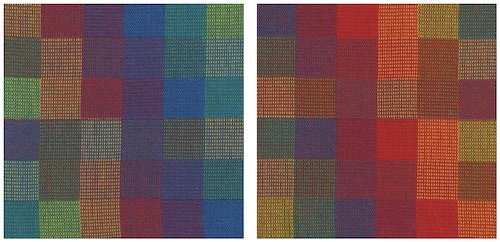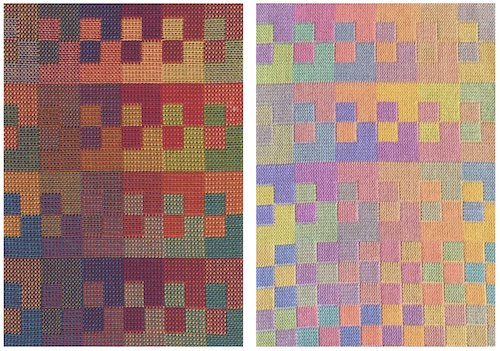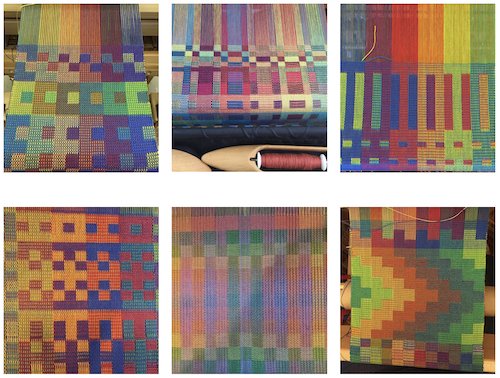Double Rainbow Evolves, part 1
I experimented with Double Rainbow warps on four shafts for several months (see the previous blog post, Color in Space and Time), each time discovering more ways that the same warp setup could be woven. Since it is a doubleweave with each layer set the same as if it were a single layer, the total sett is twice as dense. This means that it can be woven as warp rep with a thick and thin weft, and it can be woven as a warp-faced single layer using any four shaft tie-up and treadling pattern. It turns out to be an incredibly versatile warp setup, and the experimentation can go on and on.
I began teaching Double Rainbow in 2017 as a workshop for four shaft looms. In order to have an orderly system for weaving the 4-shaft sampler that ensures that all the possibilities are covered, I use one of the warp colors as the weft for the top layer and the complementary color as the weft for the bottom layer, weaving squares of all six layer combinations before rotating to the next pair of weft colors. This means that a different pair of warp colors are being woven on each layer, and opposite complementary colors are being woven with them in the weft, resulting in two entirely different combinations of colors on the two faces of the cloth.
Two sides of one section of the sampler, one side woven with blue weft and one side woven with orange weft
Then I started thinking about setting up this color rotation system in two blocks of doubleweave on eight shafts. I broke up each of the warp color bands into blocks, both by dividing each color block in half and dividing each color block into thirds. How I think of this is that you have two separate four-shaft looms, each of which can operate independently, or have a mind of its own. So within the two structural blocks in each warp color band, both of them can have one set of warp colors on top, both of them can have the opposite set of warp colors on top, or they can have opposite sets of warp colors on top in two different orientations. This means that you can have what was on opposite sides of the cloth on four shafts, now both appearing on the top layer side by side, which creates a potential for much higher contrast between the color combinations.
Two blocks with color bands divided in half, woven in saturated bright colors and in tints
There is so much information in these samplers about color theory, how optical mixtures work, and how colors interact with each other and affect each other. For example, the same combination of colors can meld together into a neutral if they are blended evenly at a small scale, or they can contrast strongly with each other if they are grouped into larger design areas. I like these pieces as finished weavings in their own right, and also as studies with endless ideas for future projects.
Two blocks with color bands divided in thirds, woven in saturated bright colors
It’s always fun for me to walk around the room during a workshop and see what my students come up with, particularly once they start experimenting with two blocks. Because there are endless ways that the blocks can be treadled and which colors are used in both the warp and the weft, I see new combinations every time I teach this workshop. Here are just a few examples of samplers in progress during some of my workshops -
About three years ago I was in Durango CO attending the Intermountain Weavers Conference. Going through the vendor hall I saw that the Lone Star Loom Room had Rosalie Nielson’s new box set, An Exaltation of Blocks. It felt like a splurge, but one I didn’t need to think about for very long. Wow! Rosalie has done an astounding job of organizing literally billions of possible block combinations into a neat and comprehensible package. And that’s just for up to four blocks with symmetrical designs. Envelopes full of transparent overlays let you play and play with different ways of placing the block designs together for as long as you are able to stay awake.
My mind has been whirling ever since thinking about how I can weave up to eight blocks of doubleweave on my 32-shaft compudobby loom. And the freedom of being able to place those blocks in any order I want, both symmetrically and asymmetrically. And then overlaying the endless possibilities of color rotation on top of those…
To be continued…





